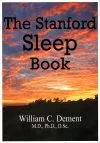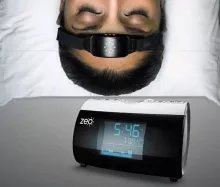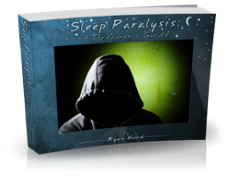
| Connect & Subscribe |
Sleepwalking - Do You Know What You Did Last Night? A Brochure
An Outreach Project by Joy O'Hare | Return To Outreach Projects 2010
The following is a brochure created for Stanford Sleep and Dreams. If it is difficult to read using the images, you may view the full text here.
Also feel free to download this brochure for distributional or general information purposes. Please refer to our privacy policy for our relevant disclaimers.
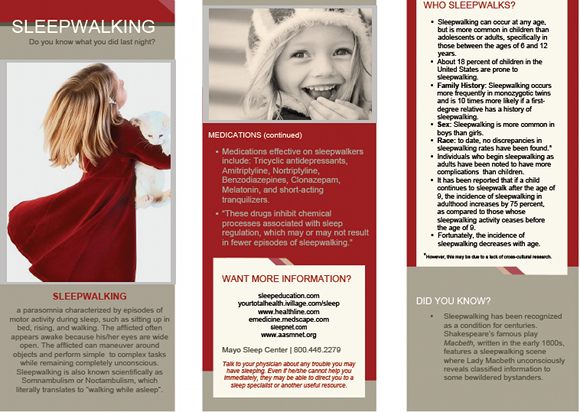
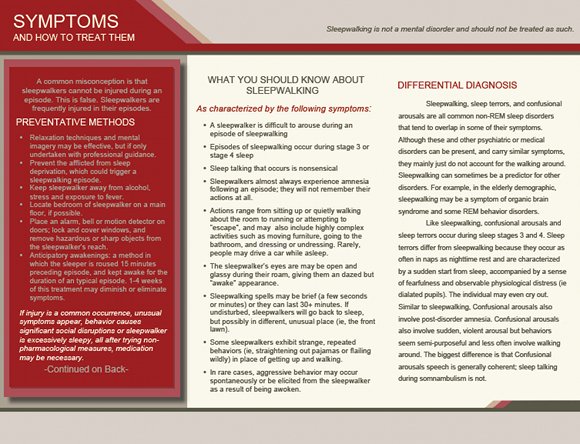
Sleepwalking
a parasomnia characterized by episodes of motor activity during sleep, such as sitting up in bed, rising, and walking. The afflicted often appears awake because his/her eyes are wide open. The afflicted can maneuver around objects and perform simple to complex tasks while remaining completely unconscious. Sleepwalking is also known scientifically as Somnambulism or Noctambulism, which literally translates to "walking while asleep".
Who Sleepwalks?
*However, this may be due to a lack of cross-cultural research.
Symptoms and how to treat them
A common misconception is that sleepwalkers cannot be injured during an episode. This is false. Sleepwalkers are frequently injured in their episodes.
Differential Diagnosis
Sleepwalking, sleep terrors, and confusional arousals are all common non-REM sleep disorders that tend to overlap in some of their symptoms. Although these and other psychiatric or medical disorders can be present, and carry similar symptoms, they mainly just do not account for the walking around. Sleepwalking can sometimes be a predictor for other disorders. For example, in the elderly demographic, sleepwalking may be a symptom of organic brain syndrome and some REM behavior disorders.
Like sleepwalking, confusional arousals and sleep terrors occur during sleep stages 3 and 4. Sleep terrors differ from sleepwalking because they occur as often in naps as nighttime rest and are characterized by a sudden start from sleep, accompanied by a sense of fearfulness and observable physiological distress (ie dialated pupils). The individual may even cry out. Similar to sleepwalking, Confusional arousals also involve post-disorder amnesia. Confusional arousals also involve sudden, violent arousal but behaviors seem semi-purposeful and less often involve walking around. The biggest difference is that Confusional arousals speech is generally coherent; sleep talking during somnambulism is not.
PREVENTATIVE METHODS
If injury is a common occurrence, unusual symptoms appear, behavior causes significant social disruptions or sleepwalker is excessively sleepy, all after trying non- pharmacological measures, medication may be necessary.
Did you know?
Sleepwalking has been recognized as a condition for centuries. Shakespeare's famous play Macbeth, written in the early 1600s, features a sleepwalking scene where Lady Macbeth unconsciously reveals classified information to some bewildered bystanders.
Want more information?
sleepeducation.com
yourtotalhealth.ivillage.com/sleep
www.healthline.com
emedicine.medscape.com
sleepnet.com
www.aasmnet.org
Mayo Sleep Center | 800.446.2279
Talk to your physician about any trouble you may have sleeping. Even if he/she cannot help you immediately, they may be able to direct you to a sleep specialist or another useful resource.
About This Site
Welcome! This site is continuously being created by students of Dr. William C. Dement's Sleep And Dreams course at Stanford University.
We made this site as a call to action for people all over the world to live healthier, happier, safer, and more productive lives by learning about their own sleep. We have faith that reading the information provided on this site will motivate you to be smart about your sleep deprivation and strategic about your alertness in order to live life to your fullest, most energetic potential.
In fact, we challenge you to do so! What do you say, are you up for the challenge?
Interviews With Sleep Specialists: Insights Into the Worlds of Sleep Medicine & Sleep Business
America's Most Dangerous Disorder: What Is Sleep Apnea Doing To Your Sleep?
Sleep Debt: How Much More Will You Achieve When You Reduce Yours?
The Stages Of Sleep: The Journey Through The Night
Delayed Sleep Phase: You Want To Sleep But You're Not Tired Yet
The Stanford Sleep Book
Dr. Dement's pioneering textbook has been the core text for Sleep and Dreams since 1980, but it has just recently been made available to the wider public for the first time.
In it you'll find a more detailed account of the most important things you need to know about sleep, alertness, dreams, and sleep disorders. Studies, statistics, plus plenty of Dr. Dement's classic anecdotes painting the history of sleep medicine.
Preface | Intro | Contents | Get A Copy
More Sleep Resources
The Zeo
A revolution in personal sleep tracking, the Zeo is a wireless headband that transmits your brainwaves in realtime to a dock (pictured here) or your smartphone. The result? You can wake up and see exactly what stages of sleep you were in during the night! Unprecedented personalized sleep knowledge.
Sleep Paralysis: A Dreamer's Guide
Ever woken up paralyzed? A surprising number of us have, believe it or not. But few know the actual causes of this phenomenon, and fewer still how to exert control over it. Dream researcher and sleep paralysis expert Ryan Hurd shares breakthrough insights into how to do just that.
Important Disclaimer
Please Note:
The information found on this page and throughout this site is intended for general information purposes only. While it may prove useful and empowering, it is NOT intended as a substitute for the expertise and judgments of healthcare practitioners.
For more info, see our
Terms of Use.







